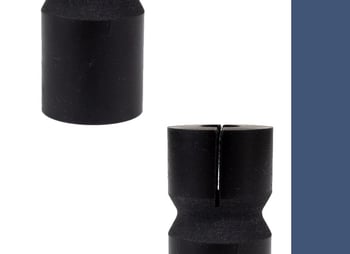Polyurethane Impact Resistance
Ever dropped or bumped into something and panicked in hopes that it didn’t break? Well, that huge sigh of relief you may have experienced was probably the outcome of a well-executed product design - from innovation to iteration. Understanding a material's impact resistance early in the product development stage is critical for prolonged wear life or preventing any catastrophic failures from occurring. In this post, we will break down the importance of impact resistance when designing polyurethane products, how impact resistance is measured, and important considerations for your design.
What is Impact Resistance
Impact resistance is a key physical property used to describe a material’s ability to withstand deformation caused by force when two or more objects collide. Most bumpers, for example, are designed with high strength materials to absorb impact and protect the application or user from any harm. Brittle materials, such as some plastics or glass, tend to exhibit low absorption rates and weaken easily upon impact.
How to Measure Impact Resistance
There are several ways to determine a material's impact resistance. For starters, Charpy and Izod impact strength tests are two common methods used in controlled laboratory environments to gauge the amount of energy a material can absorb by a weighted pendulum. Another common method is a simple drop test. As the name implies, this method often consists of dropping objects on the material or dropping the material itself until it shows signs of brittleness. Typically, this method is uncontrolled and measured in the form of pass or fail checks. The material and its function will determine the proper measuring method to employ. For accurate results, there are standard methods, such as ASTM D256, that are frequently used to measure impact resistance.
Impact Resistance of Polyurethanes Compared to Other Materials
Impact resistance can differ based on the type of material employed, its thickness, and environmental conditions. However, materials such as thermoset polyurethanes can offer product designers controlled results and improved performance through their custom formulations. As a result, this unique material can be as soft and flexible as a cushion, or as hard and rigid as a rock. While materials, such as some metals, may exhibit greater impact resistance when compared to thermoset polyurethanes, it may be more difficult to combine improved impact resistance with other key performance properties.
hard and rigid as a rock. While materials, such as some metals, may exhibit greater impact resistance when compared to thermoset polyurethanes, it may be more difficult to combine improved impact resistance with other key performance properties.
How to Use Impact Resistance in Your Design
Applications, such as medical devices, military & defense, and robotics to name a few, frequently require high-impact resistant materials for strength and longevity. Take the bumper concept as an example. This product, generally constructed of thermoplastics and metals, acts as a shield to absorb high-impact. Depending on the maximum force applied and its environmental conditions, a bumper may become brittle and cause significant harm to the product or user. To prevent any machine downtime or any catastrophic events from occurring, thermoset polyurethanes should be considered over thermoplastics for their customizable physical properties to meet exact product design requirements. To get an idea of how thermoset polyurethanes can react under high speed and high impact, check out our mobile imaging case study here.
If you find impact resistance is a key performance requirement in your design idea, this can easily be tailored by your thermoset polyurethane manufacturer. For material assistance, complete our design tool, here, or click the button below to start your custom polyurethane design idea.





